Once upon a time, hardly anyone went to Uzbekistan. Many people didn’t even know where Uzbekistan was on a map (and some of my friends still don’t!)
But as the Stan countries become easier to enter with the introduction of e-visas or even visa free entry for many countries, destinations such as Uzbekistan and Kyrgyzstan are quickly creeping to the top of must do lists for intrepid travellers.
To help you plan your trip to this beguiling country, here’s a suggested two-week itinerary for Uzbekistan.

Days 1-2 Tashkent
Your Uzbekistan adventure will likely start in the capital of Tashkent.
Tashkent is serviced by an international and domestic airport and has flights to other Stan countries as well as Europe and other parts of Asia.
While Uzbekistan’s best sights are located in Samarkand, Bukhara and Khiva, it’s worth spending a couple of days in Tashkent.
Tashkent is a modern city as much of the capital was destroyed in an earthquake in 1966. It was subsequently rebuilt, adopting Soviet architectural styles. There’s lots of concrete and dark glass fronted buildings and huge monuments, but there’s also many beautiful buildings.
One of the top sights in Tashkent is the Khast-Imam religious complex. The Barakhan and Muyi Muborah madrasahs (Islamic schools) inside the complex date back to the 16th century. Stepping into the Barakhan madrasah, you’ll find assorted handicraft stalls featuring impressive paintings, ceramics, and textiles.
You can also take a look at Chorsu Bazaar and the nearby madrasah. Tashkent also features some impressive squares and beautiful parks.
Tashkent offers an efficient metro system – and the platforms inside the metro stations are a tourist attraction in themselves. Many of the stations are named after famous Russians or Uzbeks – and are works of art. Be aware that you are not allowed to take photos in the metro.
Each metro ticket costs 1200 UZS ($0.15 USD). Tickets must be paid with cash, and you’ll be given a token to insert into the entry gates.
My favourite metro station was Kosmonavtlar. The walls are lined with images of astronauts, including the first human in space, Yuri Gagarin.
Where To stay
Tourism is only just kicking off in Uzbekistan so there’s only a handful of hostels. But I highly recommend Art Hostel. This hostel features a pool, air-conditioning and a large common area. They also had one of the best free hostel breakfasts I had on my nine-month trip across the world – offering up everything you could want for breakfast including pancakes, fruit, eggs, oatmeal and cookies.
Where to next?
From Tashkent, you’re likely to be heading to Samarkand. The best way to reach Samarkand is by train. The journey should take about two hours. Buy your ticket at least the day before especially in high season (May-June and August-September) as trains can fill up.
Be aware that Tashkent has two train stations (north and south). The north train station is closest to the city centre. Tickets can be bought at either station – but make sure you check which station your train departs from.
You can also travel to Samarkand by shared taxi or marshrutka but the trip is twice as long as by train (4 hours).

Days 3-5 Samarkand
Samarkand is one of the jewels in Uzbekistan’s crown – and was one of the main trading posts on the Silk Road route.
If you’ve seen photos of Uzbekistan, you will have definitely come across images of Samarkand’s impressive Registan. Seeing a photo of the square flanked by two madrasahs and a mosque is what drew me to make a visit to Uzbekistan in the first place.
Registan means Sandy Place in Persian, and the square was used for public executions, and to announce royal news.
The Registan is even more impressive in real life with it’s wonderful mosaics, illuminated ceilings, towering minarets, and relaxing courtyards – and you can spend hours wandering this beautiful location.
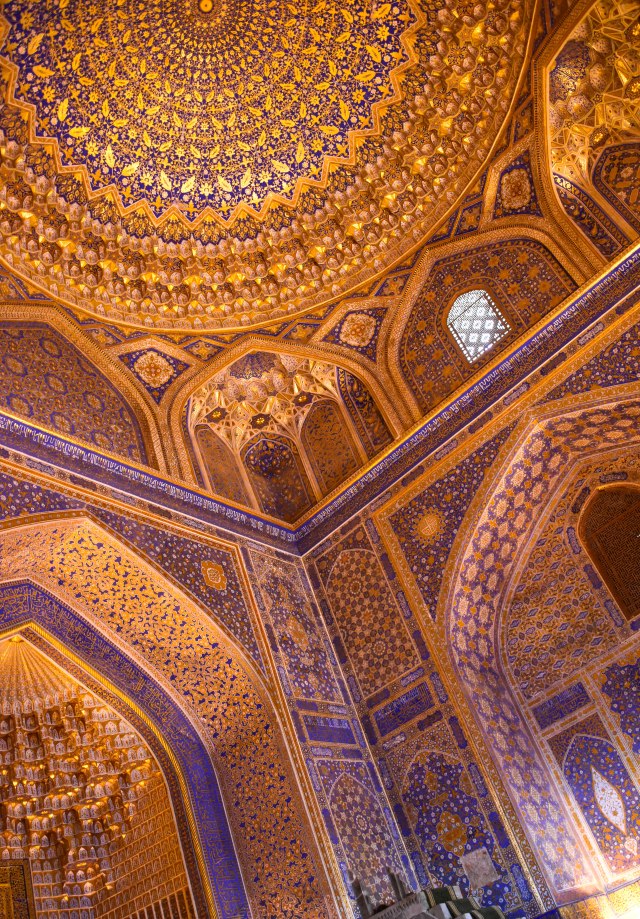
This magnificent square was built between 1370 and 1500 – and has been restored over the years since in the wake of earthquakes in the region.
Cost of entry is 30,000 UZS ($3.60 USD) and you go can inside the Registan Square complex from 9am to 6pm. You can visit the outside of the square anytime of the day though – and it’s worth getting up early to see the sunrise from here. Or you may be able to tip one of the guards to let you into the square (maybe even the minaret) before opening hours.
Other sights in Samarkand are the Gur Emir Mausoleum (the burial place of the ruler Timurlane); the Street of Tombs, Ulughbek Observatory, and the towering Bibi Khanoum Mosque.
You should also stop by the Siyob Bazaar if you’re looking for fresh fruit and vegetables, bread, nuts and even clothing. The bazaar is next to the Bibi Khanoum Mosque.



Where to stay
Amir Hostel is a great choice in Samarkand. While it’s a bit of a walk from here to the Registan, it’s in a nice location near a park and a supermarket.
Where to next?
Your next stop will likely be Bukhara. You can easily reach Bukhara by train from Samarkand in less than two hours. Bukhara’s train station is located 13km from the Old City so you’ll have to take a taxi. It’s possible to bargain with taxi drivers and expect to pay around 15,000 Soum. Try and find some other travellers heading in the same direction and you can split the price.
Interested in a day trip from Samarkand? Then check out this blog from The Wandering Westerner about how to get to Shahrisabz and what to see when you get there.

Days 6-9 Bukhara
Bukhara is another city that was located on the ancient Silk Road route and is rightly labelled as an open air museum. Around every corner, you’ll find a beautiful madrasah, mosque, square or bazaar.
Bukhara is a city built for aimless wandering – but if you’re more the tick off the list type traveller, make sure you don’t miss these sights.
- Chor Minor Mosque (Chor Minor means Four Minarets)
- Ark Fortress. The fortress dates back to the 5th century, however much of the original structure is now in ruins. The most spectacular part of the fortress is its restored exterior.
- Po-i-Kalyan Mosque complex, particularly the Kalyan Minaret. The 48 metre minaret dates back to 1127 and legend has it that criminals were thrown to their deaths from the tower in medieval times.
- Lyabi-Kauz square with its pond and madrasah
- Covered bazaar for souvenir shopping (you’ll find the bazaar under the multi-domed building on your way to the Kalyan Minaret
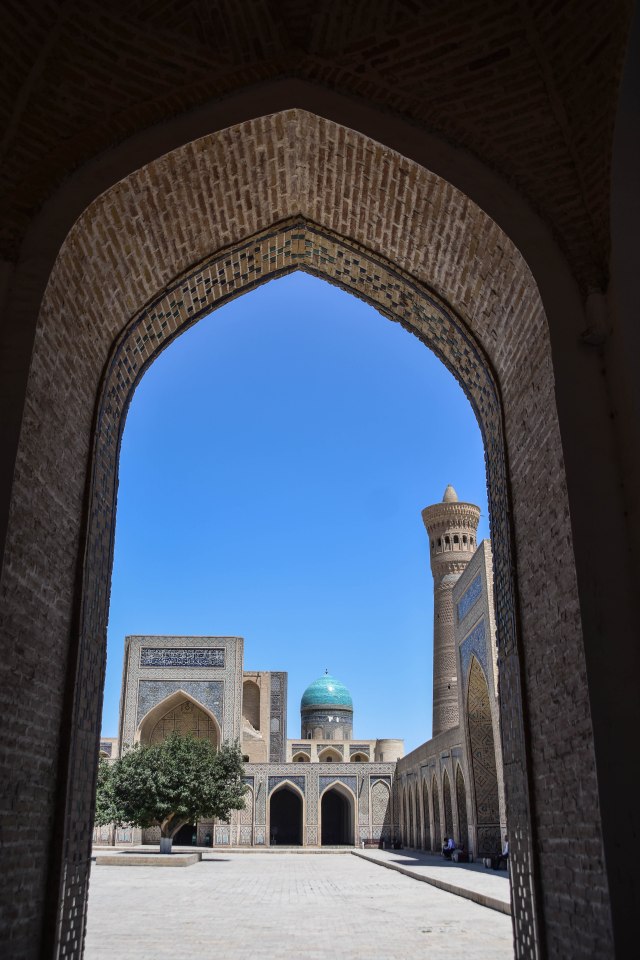



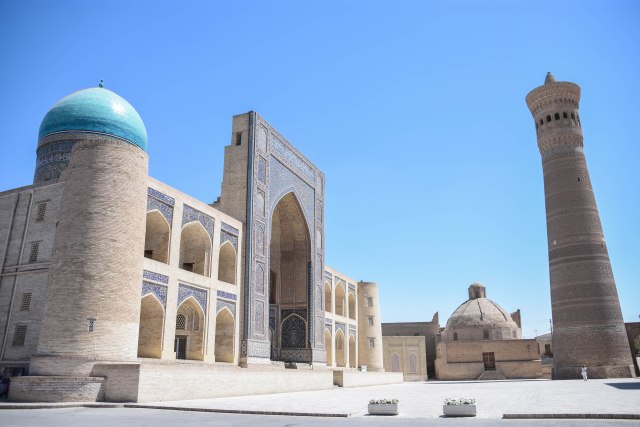
Bukhara also has a great fresh food bazaar (near the Musuem of the History of Water Supply). Close to the bazaar, you’ll stumble across the old city walls and madrasahs that are a little rough around the edges – but I think that’s part of their charm).
Where to next?
From Bukhara, you’ll want to head to Khiva. To get to Khiva from Bukhara, your best option is to take a shared taxi. The trip will take you about 6 hours. Prices may be negotiable and you can expect to pay between 80,000-120,000 Soum.
Days 9-11 Khiva
Khiva is another open-air museum, but on a smaller scale than Bukhara. The Old City of Khiva is contained within some impressive fortified city walls, and inside you’ll find beautiful minarets, stairs leading up to the old city walls, and narrow alleys which are a photographer’s dream at sunset.
You can’t miss the beautiful azure Kalta Minor Minaret as you enter the city from the West Gate. The minaret is particularly unique as it was unfinished – due to the man who ordered its construction passing away before it was completed.

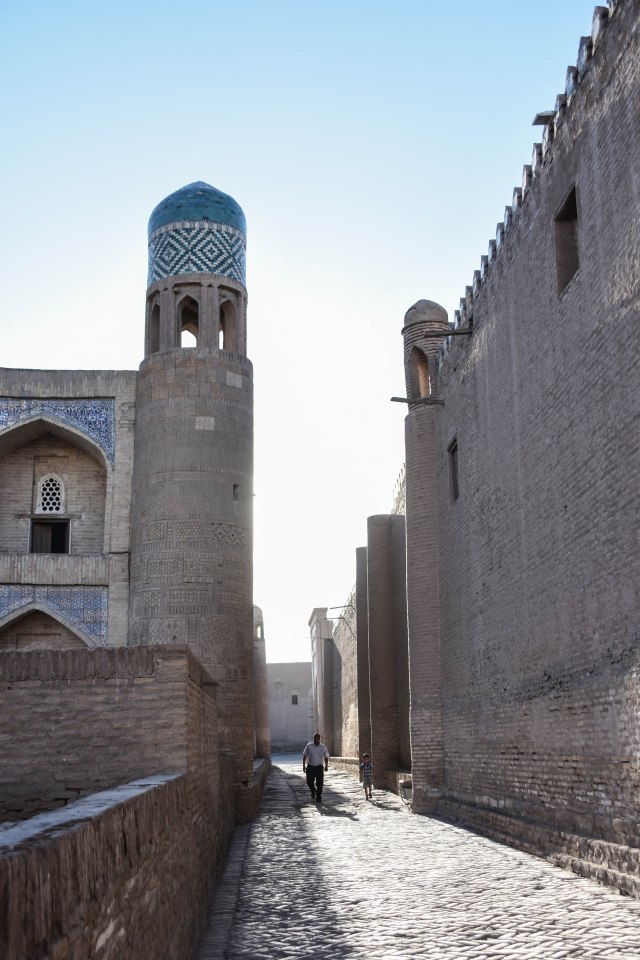

You can climb the north-western section of the city walls for free (stairs are located at the North Gate, best to wear sneakers as the stairs have some crumbly sections).
For another awesome view of the town, head up to the Kuhna Ark Watchtower. Entry is 10,000 Soum.
The best time to roam Khiva in my opinion was just after sunrise when the light was soft or at sunset – when it became golden hour in the Old City.
It’s also worth a trip to see the desert fortresses about a 90 minute drive from Khiva. The best way to do this is by hiring a driver. I organised a driver through my hostel Lali-Opa and managed to talk to other backpackers into coming along for the ride. The cost was $40 USD for the car. This was for a return trip to see two of the fortresses Toprak and Ayaz. These are considered to be the most beautiful fortresses, however there are another six fortresses in the area.
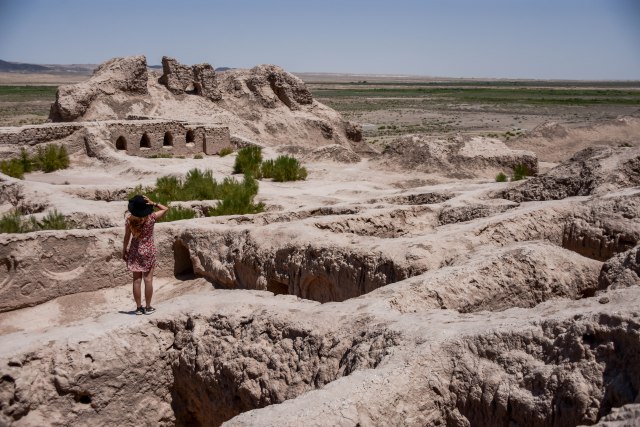
Where to Stay
There’s good accommodation options in Khiva. If you want to stay near the Old City, check out Meros B&B. If you’re looking for a hostel, head along to the friendly Lali-Opa Hostel – about 2km from the Old City.
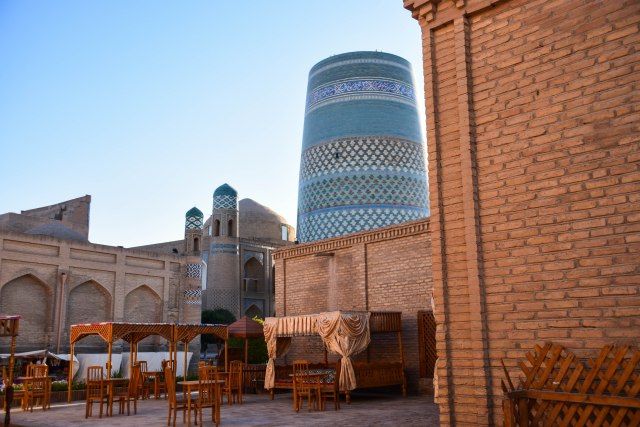
Days 12-14 Nukus & Muynak
The majority of travellers to Uzbekistan head west from Tashkent towards Khiva and then either take the night train from Khiva or fly back from Urgench airport (30 minutes drive from Khiva) to Tashkent.
If you want to get off the beaten track, you can head to Nukus from Khiva (via Urgench).
To get to Nukus, take a shared taxi to Urgench (ask to go to the Olympic Stadium taxi stand and not the bazaar) and then wait for a shared taxi to fill up to go to Nukus. Cost should be no more than 40,000 Soum but drivers will try for 50,000 Soum.
It’s a two-hour drive to Nukus. So what is there to see in Nukus? Well not much, but you should pay a visit to the famous Savitsky Museum, which houses one of the largest art collections in the former Soviet Union states. You’ll find works by Soviet artists you can’t view anywhere else in the world. Cost is 80,000 Soum for entry to the museum’s two buildings.
From Nukus, book a tour to go camping on the shores of the Aral Sea or head to Muynak – which used to be a thriving fishing town on the shores of the Aral Sea.
The Aral Sea is technically a lake (it used to be the fourth largest lake in the world) – but is now the scene of an environmental disaster.
In the 1960s, the rivers feeding the Aral Sea began to be diverted to irrigate cotton crops. The sea began to shrink markedly in the decade after, destroying the fishing industry in Muynak.



Muynak has a ghost town feel to it now – with a port building and rusty ships the only reminders of its past. It’s a unique, but sombre, place to visit.
To get to Muynak, you have two options. If you’re in a group, you can choose to ride in comfort in a private vehicle with a driver but it will set you back $70 USD.
Solo and budget travellers happy to trade comfort in order to save dollars, can take the daily bus from Nukus to Muynak. The bus departs daily from the Old Town bus station at 9am. Get there at least 30 minutes before if you want a seat. The trip takes about 3.5 hours and will cost 13,000 Soum. The distance isn’t far but the bus is very slow – only reaching a maximum speed of 70km/h.
Once you get to the bus station, take the #1 marshrutka from the bus station. Show them on the Maps.me mobile app that you want to go to the Ship Graveyard. Cost is 1000 Soum and you’ll be there in five minutes. To get back to the bus station, head back to the main road and flag down the marshrutka. They come past about every 5-10 minutes. The bus back to Nukus departs at 3pm.
On day 14 of your trip, you can head back to Tashkent from Urgench via train or plane.
Where to stay?
There’s not a lot of accommodation options in Nukus. Most travellers stay at the Jipek Joli Inn. You can opt to stay in a shared yurt, or get a private room.
Got more than 2 weeks?
Not many tourists head to Uzbekistan’s Ferghana Valley (east of Tashkent) – I ran out of time and I didn’t meet anyone who made it there – but if you love the mountains, then it might be worth a stop.

Pingback: Uzbekistan: What you need to know before you go – The Little Adventurer
Pingback: 8 destinations you should visit now – The Little Adventurer
Wow your entry here is amazing. I really love the photos you captured; there’s so much detail. I also don’t know much about the country before reading this entry, so I really appreciated the history and context. Great travel post!
Thank you so much for reading and your feedback! Really nice to hear it was a helpful blog.
I am impressed with your post here is a new post and you have prepared a new recipe not everyone can do it but you have done it I think you will become another successful person in life.